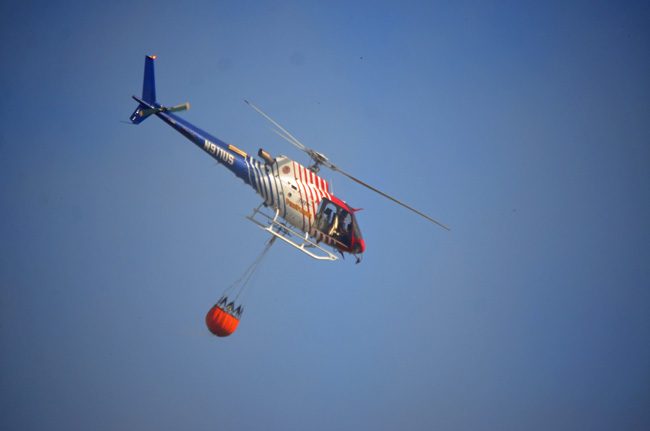
FireFlight crews used the helicopter’s ability to travel anywhere within the county in 15 minutes with its 210-gallon water bucket to prevent a wildfire from getting out of control on July 16, the county said in a release.
Helicopter Pilot Todd Whaley, who is also a Florida certified Wild-Land Firefighter, was called off a support mission to assist firefighters on the ground with two small brush fires in western Flagler County. As he left the area, he could see a column of smoke to the southeast, and found 3 acres burning near Plantation Bay.
As he approached, Whaley was surprised by the embers and ash hitting the copter’s wind screen – atypical given the recent rainy, wet weather conditions. He immediately called the Florida Forest Service.
Often after lightning sparks a fire, Whaley will direct ground crews to the blaze–ready with the “Bambi Bucket” if the fire cannot easily be reached. In this case, he started dropping water on it right away.
Flagler County Engine 16 responded to the area, but couldn’t reach the fire. Whaley scooped and dropped 44 buckets of water – 9,500 gallons – on the fire in about an hour. Though Florida Forest Service was delayed in its response because of the westside fires, Whaley and FireFlight were able to contain the fire to 9 acres. “We took the life out of it,” Whaley said.
Engine 16 crew Captain Richard Bennett credits Whaley and the copter with preventing the fire from spreading. “It could have easily grown to 50 acres before ground crews could access it,” he said.
Given its many functions – including patient transportation, search and rescue, and law enforcement assistance – people often ask why FireFlight was given its name. It was purchased after the ’98 wildfires – the first time in US history that an entire county was evacuated due to wildfire. During those fires 71 homes were destroyed, and another 175 homes were damaged.
About 82,000 acres of timber – valued at $4,000 per acre – burned. The timber loss alone was $328 million. Flagler County spent about $1.3 million in protective measures in 1998.
FireFlight was purchased in 2002 for $1.55 million with Landfill Bond money designated for fire suppression. No General Fund money was used.
Countless wildfires have been quashed with the help of FireFlight, which is a great asset to Flagler County. More than 1.2 million gallons of water have been dropped on fires since 2002.
An even more frequent question: why isn’t FireFlight a 24-hour operation? The helicopter operates out of Station 92 at the Flagler County Airport but is on only 12 hours of every 24. The county routinely must rely on emergency helicopters from St. Johns or Volusia County to conduct patient evacuations or assist law enforcement outside of those hours.





























Concerned Citizen says
As a current emergency services volunteer and retired Fire Fighter/EMT
We are very fortunate to have this capability on hand in Flagler County. Many times Fire Flight has been on Fire Recon and is able to detect brush fires in the smoldering stage or just flaring up. This is very important and gives ground crews lead time to manage it.
My understanding from the 98 Wildfires losses was a shortage of air support. With fire flight that mitigates that problem. Now if our BOCC can just get a budget together and get us 24/7 coverage again.
Kevin Walker says
It would be ideal for this operation to be available 24/7/365, well worth the cost.
Concerned Citizen says
I was around when the initial decision was made by our BOCC to cut 24/7 coverage. Their reasoning was budget costs. Yes it does cost to maintain a helo and crews 24/7. But adequet Emergency Services coverage is a mandatory obligation the county is required to furnish.
Instead of over paid staff and double dipping assistants that money could be used to provide the coverage needed for Fire Flight
Just my 2 cents. Not that it matters.
John dolan esq. says
Great job. Thanks for your service.
Kristi Medlin says
This wonderful helicopter saved our home beachside when we didn’t have hydrants. We will be forever grateful. They were amazing.